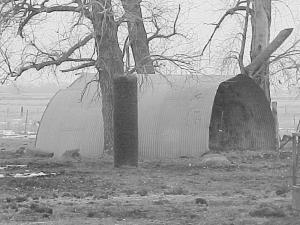2002 - Volume #26, Issue #1, Page #06
[ Sample Stories From This Issue | List of All Stories In This Issue | Print this story
| Read this issue]
Wrecked Bins Make Low-Cost Shelters
 |
At the same time, though, he didn't want to make a major investment in buildings.
"A windstorm in 1996 knocked over a couple of empty grain bins. I had salvaged the drying floors out of them, but the bins were wrecked and lying there on their sides," he says. As he looked at those bins, it struck him that he could turn them into cattle shelters.
He unbolted and removed the roof from the bins and then, using a cutting torch, cut each bin in half to make two quonset-like sheds, open at both ends.
"I cabled the bottom edges together so they wouldn't spread, putting the cable down low to the ground so I can drive into them with a tractor and scrape out manure," he says. "I was going to drive posts and anchor them, but they've stayed put, so that may not be necessary."
His grain bin shelters are 18 ft. long, 18 ft. wide, and about 9 ft. high at the peak of the arch. They're set with the open ends facing northeast and southwest, to avoid becoming wind tunnels when winter winds blow from the northwest.
He turned one arch into a calf shed by putting rails of 2 by 6-in. boards across the ends at the right height to keep the cows out. He puts a creep feeder inside this one when calves are small.
The sheds can be relocated by driving a loader tractor inside and lifting the loader in the center of the shed. With the shed centered over the tractor and lifted off the ground a few inches, he can drive it to wherever he wants. "Moving them makes cleaning up around them a lot easier," he says.
Braton says cutting the bins in half with an acetylene torch took less than half an hour. "I started trying to unbolt the panels and cutting the ones that didn't line up, but that was taking a long time," he says. Since having a perfectly flat edge to put onto the ground wasn't important, he figured it would be better to do the job quickly. He adds that unbolting the roofs to remove them took longer than cutting the bins in half. He says his only costs were the cables and hardware to tie the sides together and the gas to run the torch.
Contact: FARM SHOW Followup, Jeffrey Braton, 2862 110th St., Barnesville, Minn. 56514 (ph 218 493-4582; E-mail: jeffreyb@rrt.net).

Click here to download page story appeared in.

Click here to read entire issue
To read the rest of this story, download this issue below or click here to register with your account number.




